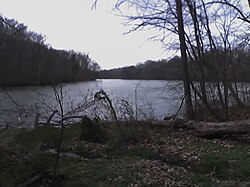Lake Roland, Maryland
| Lake Roland | |
|---|---|

Lake Roland
|
|
| Location | Towson, Baltimore County, Maryland |
| Coordinates | 39°22′42″N 076°38′35″W / 39.37833°N 76.64306°WCoordinates: 39°22′42″N 076°38′35″W / 39.37833°N 76.64306°W |
| Type | reservoir |
| Primary inflows | Jones Falls, Towson Run, Roland Run |
| Primary outflows | Jones Falls |
| Basin countries | United States |
| Surface area | 100 acres (40 ha) |
| Surface elevation | 246 ft (75 m) |
Lake Roland is a 100-acre (0.40 km2) defunct reservoir in Baltimore County, Maryland. It was named for Roland Run, a nearby stream-bed that feeds the lake and eventually flows into the Jones Falls. It runs southeast through the city center to the Northwest Branch of the Patapsco River and the Baltimore Harbor. It is located just north outside of the city limits.
The lake is contained within the bounds of Lake Roland Park, which was established in the 1920s and supervised by the newly organized Baltimore City Department of Parks and Recreation. The lake is an artificial impoundment created by a dam on the Jones Falls and two smaller streams: Towson Run and Roland Run. The lake supports wildlife including Canada geese, largemouth bass, and common carp. The lake is part of the Lake Roland Historic District.
The lake was once called Lake Swann to honor Mayor Thomas Swann of Baltimore City, who had begun the construction of the dam at the Relay House then on the Northern Central Railroad. The name Roland comes from Roland Run which was named sometime before 1694 when Roland or Rowland Thornberry owned a land tract in the area.
In 1854, the City of Baltimore bought the entire holdings of the privately owned Baltimore Water Company, which had supplied water to the city for fifty years, accompanied by acquisition of the land held by the Bellona Gunpowder Mill and the Eagle Factory, a textile mill, by 1857 for $289,000. This purchase followed a political controversy regarding the failure of the company to extend new water lines into surrounding out-lying areas of the city. The city had added territory in its last annexation in 1818. As a result of the new ownership of the area, certain industries became displaced. These included the Bellona Gunpowder Mill which had operated from at least 1801 on the west side of the lake, and the Eagle Factory, which had operated there since at least 1814, while the Baltimore & Susquehana Railroad stayed in place, with destruction by pro-Confederate forces during the American Civil War and reconstruction by pro-Union forces as they advanced southward.
...
Wikipedia
